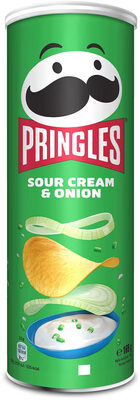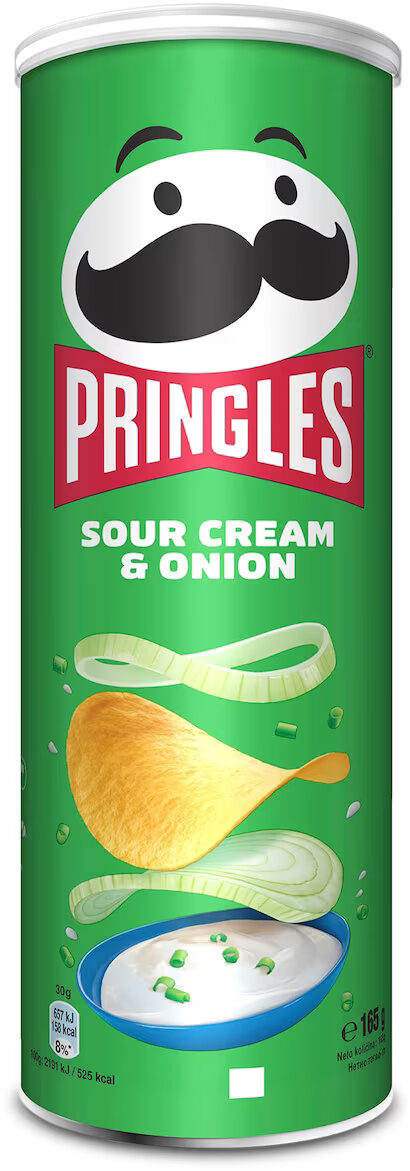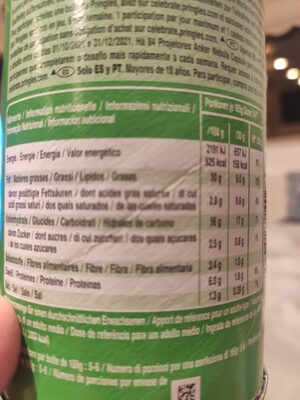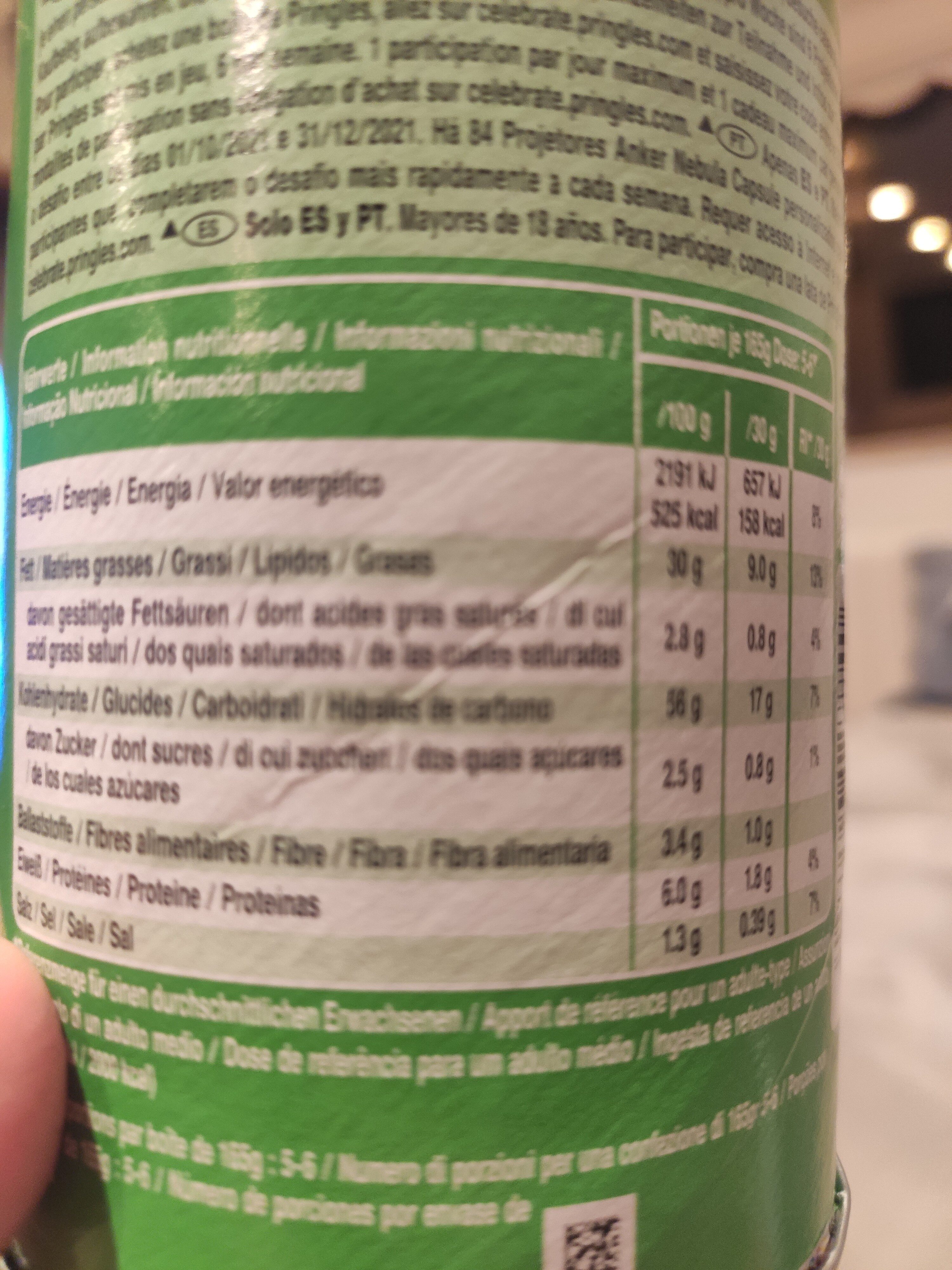Help us make food transparency the norm!
As a non-profit organization, we depend on your donations to continue informing consumers around the world about what they eat.
The food revolution starts with you!
Pringles Sour Cream & Onion - 165g
Pringles Sour Cream & Onion - 165g
This product page is not complete. You can help to complete it by editing it and adding more data from the photos we have, or by taking more photos using the app for Android or iPhone/iPad. Thank you!
×
Barra-kodea: 5053990127740 (EAN / EAN-13)
Izen arrunta: Producto de aperitivo frito con sabor a nata acidificada y cebolla
Kopurua: 165g
Ontziratzea: en:Tube, en:card-tube, en:container, en:pp-lid
Markak: Pringles
Kategoriak: en:Snacks, en:Salty snacks, en:Appetizers, en:Chips and fries, en:Crisps, en:Salty snacks made from potato, en:Tuiles salées
Etiketak, ziurtagiriak, sariak: en:Point Vert, en:Végétarien
Link to the product page on the official site of the producer: https://www.pringles.com/es/products/Sab...
Dendak: Mercadona
Saltzen diren herrialdeak: Frantzia, Senegal, Espainia, en:Allemagne, en:Espagne
Matching with your preferences
Health
Osagaiak
-
37 ingredients
Gaztelania: Patatas deshidratadas, aceites vegetales (girasol, maíz), harina de arroz, almidón de trigo, harina de maíz, condimento a base de nata acidificada y cebolla (almidón de trigo, potenciadores del sabor (glutamato de monosodio, guanilato disódico, inosinato disódico), cebolla en polvo, maltodextrina, sal, dextrosa, azúcar, suero de leche dulce en polvo, almidón de patata, almidón de maíz modificado, acidulantes (ácido cítrico, ácido láctico, ácido málico) nata acidificada en polvo (leche), aromas (leche), extracto de levadura, jarabe de glucosa, proteínas de la leche, harina de arroz), emulgente (E471), maltodextrina, sal, colorante (norbixina de annato).Alergenoak: en:Gluten, en:MilkAztarnak: en:Soybeans
Food processing
-
Ultra processed foods
Elements that indicate the product is in the 4 - Ultra prozesatutako elikagaiak eta edariak group:
- Gehigarria: E160b
- Gehigarria: E471
- Gehigarria: E621
- Gehigarria: E627
- Gehigarria: E631
- Osagaia: Colour
- Osagaia: Dextrose
- Osagaia: Emulsifier
- Osagaia: Flavour enhancer
- Osagaia: Flavouring
- Osagaia: Glukosa
- Osagaia: Almibar
- Osagaia: Maltodextrin
- Osagaia: Milk proteins
Food products are classified into 4 groups according to their degree of processing:
- Prozesatu gabeko edo ahalik eta gutxien prozesatutako elikagaiak
- Sukaldaritzako osagaiak prozesatu
- Prozesatutako jakiak
- Ultra processed foods
The determination of the group is based on the category of the product and on the ingredients it contains.
Gehigarriak
-
E270
Lactic acid: Lactic acid is an organic compound with the formula CH3CH-OH-COOH. In its solid state, it is white and water-soluble. In its liquid state, it is colorless. It is produced both naturally and synthetically. With a hydroxyl group adjacent to the carboxyl group, lactic acid is classified as an alpha-hydroxy acid -AHA-. In the form of its conjugate base called lactate, it plays a role in several biochemical processes. In solution, it can ionize a proton from the carboxyl group, producing the lactate ion CH3CH-OH-CO−2. Compared to acetic acid, its pKa is 1 unit less, meaning lactic acid deprotonates ten times more easily than acetic acid does. This higher acidity is the consequence of the intramolecular hydrogen bonding between the α-hydroxyl and the carboxylate group. Lactic acid is chiral, consisting of two optical isomers. One is known as L--+--lactic acid or -S--lactic acid and the other, its mirror image, is D--−--lactic acid or -R--lactic acid. A mixture of the two in equal amounts is called DL-lactic acid, or racemic lactic acid. Lactic acid is hygroscopic. DL-lactic acid is miscible with water and with ethanol above its melting point which is around 17 or 18 °C. D-lactic acid and L-lactic acid have a higher melting point. In animals, L-lactate is constantly produced from pyruvate via the enzyme lactate dehydrogenase -LDH- in a process of fermentation during normal metabolism and exercise. It does not increase in concentration until the rate of lactate production exceeds the rate of lactate removal, which is governed by a number of factors, including monocarboxylate transporters, concentration and isoform of LDH, and oxidative capacity of tissues. The concentration of blood lactate is usually 1–2 mM at rest, but can rise to over 20 mM during intense exertion and as high as 25 mM afterward. In addition to other biological roles, L-lactic acid is the primary endogenous agonist of hydroxycarboxylic acid receptor 1 -HCA1-, which is a Gi/o-coupled G protein-coupled receptor -GPCR-.In industry, lactic acid fermentation is performed by lactic acid bacteria, which convert simple carbohydrates such as glucose, sucrose, or galactose to lactic acid. These bacteria can also grow in the mouth; the acid they produce is responsible for the tooth decay known as caries. In medicine, lactate is one of the main components of lactated Ringer's solution and Hartmann's solution. These intravenous fluids consist of sodium and potassium cations along with lactate and chloride anions in solution with distilled water, generally in concentrations isotonic with human blood. It is most commonly used for fluid resuscitation after blood loss due to trauma, surgery, or burns.Source: Wikipedia (Ingeles)
-
E296 - Azido maliko
Malic acid: Malic acid is an organic compound with the molecular formula C4H6O5. It is a dicarboxylic acid that is made by all living organisms, contributes to the pleasantly sour taste of fruits, and is used as a food additive. Malic acid has two stereoisomeric forms -L- and D-enantiomers-, though only the L-isomer exists naturally. The salts and esters of malic acid are known as malates. The malate anion is an intermediate in the citric acid cycle.Source: Wikipedia (Ingeles)
-
E330 - Azido zitriko
Citric acid: Citric acid is a weak organic acid that has the chemical formula C6H8O7. It occurs naturally in citrus fruits. In biochemistry, it is an intermediate in the citric acid cycle, which occurs in the metabolism of all aerobic organisms. More than a million tons of citric acid are manufactured every year. It is used widely as an acidifier, as a flavoring and chelating agent.A citrate is a derivative of citric acid; that is, the salts, esters, and the polyatomic anion found in solution. An example of the former, a salt is trisodium citrate; an ester is triethyl citrate. When part of a salt, the formula of the citrate ion is written as C6H5O3−7 or C3H5O-COO-3−3.Source: Wikipedia (Ingeles)
-
E471
Mono- and diglycerides of fatty acids: Mono- and diglycerides of fatty acids -E471- refers to a food additive composed of diglycerides and monoglycerides which is used as an emulsifier. This mixture is also sometimes referred to as partial glycerides.Source: Wikipedia (Ingeles)
-
E621
Monosodium glutamate: Monosodium glutamate -MSG, also known as sodium glutamate- is the sodium salt of glutamic acid, one of the most abundant naturally occurring non-essential amino acids. Glutamic acid is found naturally in tomatoes, grapes, cheese, mushrooms and other foods.MSG is used in the food industry as a flavor enhancer with an umami taste that intensifies the meaty, savory flavor of food, as naturally occurring glutamate does in foods such as stews and meat soups. It was first prepared in 1908 by Japanese biochemist Kikunae Ikeda, who was trying to isolate and duplicate the savory taste of kombu, an edible seaweed used as a base for many Japanese soups. MSG as a flavor enhancer balances, blends, and rounds the perception of other tastes.The U.S. Food and Drug Administration has given MSG its generally recognized as safe -GRAS- designation. A popular belief is that large doses of MSG can cause headaches and other feelings of discomfort, known as "Chinese restaurant syndrome," but double-blind tests fail to find evidence of such a reaction. The European Union classifies it as a food additive permitted in certain foods and subject to quantitative limits. MSG has the HS code 29224220 and the E number E621.Source: Wikipedia (Ingeles)
-
E627
Disodium guanylate: Disodium guanylate, also known as sodium 5'-guanylate and disodium 5'-guanylate, is a natural sodium salt of the flavor enhancing nucleotide guanosine monophosphate -GMP-. Disodium guanylate is a food additive with the E number E627. It is commonly used in conjunction with glutamic acid. As it is a fairly expensive additive, it is not used independently of glutamic acid; if disodium guanylate is present in a list of ingredients but MSG does not appear to be, it is likely that glutamic acid is provided as part of another ingredient such as a processed soy protein complex. It is often added to foods in conjunction with disodium inosinate; the combination is known as disodium 5'-ribonucleotides. Disodium guanylate is produced from dried seaweed and is often added to instant noodles, potato chips and other snacks, savory rice, tinned vegetables, cured meats, and packaged soup.Source: Wikipedia (Ingeles)
-
E631
Disodium inosinate: Disodium inosinate -E631- is the disodium salt of inosinic acid with the chemical formula C10H11N4Na2O8P. It is used as a food additive and often found in instant noodles, potato chips, and a variety of other snacks. Although it can be obtained from bacterial fermentation of sugars, it is often commercially prepared from animal sources.Source: Wikipedia (Ingeles)
Ingredients analysis
-
en:May contain palm oil
Ingredients that may contain palm oil: E471
-
en:Non-vegan
Non-vegan ingredients: en:Milk proteinsSome ingredients could not be recognized.
We need your help!
You can help us recognize more ingredients and better analyze the list of ingredients for this product and others:
- Edit this product page to correct spelling mistakes in the ingredients list, and/or to remove ingredients in other languages and sentences that are not related to the ingredients.
- Add new entries, synonyms or translations to our multilingual lists of ingredients, ingredient processing methods, and labels.
If you would like to help, join the #ingredients channel on our Slack discussion space and/or learn about ingredients analysis on our wiki. Thank you!
-
en:Vegetarian status unknown
Unrecognized ingredients: es:condimento-a-base-de-nata-acidificada-y-cebolla, es:suero-de-leche-dulce-en-polvo, es:nata-acidificada-en-polvo, es:norbixina-de-annatoSome ingredients could not be recognized.
We need your help!
You can help us recognize more ingredients and better analyze the list of ingredients for this product and others:
- Edit this product page to correct spelling mistakes in the ingredients list, and/or to remove ingredients in other languages and sentences that are not related to the ingredients.
- Add new entries, synonyms or translations to our multilingual lists of ingredients, ingredient processing methods, and labels.
If you would like to help, join the #ingredients channel on our Slack discussion space and/or learn about ingredients analysis on our wiki. Thank you!
-
Details of the analysis of the ingredients
We need your help!
Some ingredients could not be recognized.
We need your help!
You can help us recognize more ingredients and better analyze the list of ingredients for this product and others:
- Edit this product page to correct spelling mistakes in the ingredients list, and/or to remove ingredients in other languages and sentences that are not related to the ingredients.
- Add new entries, synonyms or translations to our multilingual lists of ingredients, ingredient processing methods, and labels.
If you would like to help, join the #ingredients channel on our Slack discussion space and/or learn about ingredients analysis on our wiki. Thank you!
es: Patatas, aceites vegetales (girasol, maíz), harina de arroz, almidón de _trigo_, harina de maíz, condimento a base de nata acidificada y cebolla (almidón de _trigo_, potenciadores del sabor (glutamato de monosodio, guanilato disódico, inosinato disódico), cebolla, maltodextrina, sal, dextrosa, azúcar, suero de _leche_ dulce en polvo, almidón de patata, almidón de maíz modificado, acidulantes (ácido cítrico, ácido láctico, ácido málico), nata acidificada en polvo, aromas, extracto de levadura, jarabe de glucosa, proteínas de la _leche_, harina de arroz), emulgente (e471), maltodextrina, sal, colorante (norbixina de annato)- Patatas -> en:potato - vegan: yes - vegetarian: yes - ciqual_food_code: 4003 - percent_min: 10 - percent_max: 100
- aceites vegetales -> en:vegetable-oil - vegan: yes - vegetarian: yes - from_palm_oil: maybe - percent_min: 0 - percent_max: 50
- girasol -> en:sunflower - vegan: yes - vegetarian: yes - percent_min: 0 - percent_max: 50
- maíz -> en:corn - vegan: yes - vegetarian: yes - ciqual_food_code: 9200 - percent_min: 0 - percent_max: 25
- harina de arroz -> en:rice-flour - vegan: yes - vegetarian: yes - ciqual_food_code: 9520 - percent_min: 0 - percent_max: 33.3333333333333
- almidón de _trigo_ -> en:wheat-starch - vegan: yes - vegetarian: yes - ciqual_proxy_food_code: 9510 - percent_min: 0 - percent_max: 25
- harina de maíz -> en:corn-flour - vegan: yes - vegetarian: yes - ciqual_food_code: 9545 - percent_min: 0 - percent_max: 20
- condimento a base de nata acidificada y cebolla -> es:condimento-a-base-de-nata-acidificada-y-cebolla - percent_min: 0 - percent_max: 16.6666666666667
- almidón de _trigo_ -> en:wheat-starch - vegan: yes - vegetarian: yes - ciqual_proxy_food_code: 9510 - percent_min: 0 - percent_max: 16.6666666666667
- potenciadores del sabor -> en:flavour-enhancer - percent_min: 0 - percent_max: 8.33333333333333
- glutamato de monosodio -> en:e621 - vegan: yes - vegetarian: yes - percent_min: 0 - percent_max: 8.33333333333333
- guanilato disódico -> en:e627 - vegan: maybe - vegetarian: maybe - percent_min: 0 - percent_max: 4.16666666666667
- inosinato disódico -> en:e631 - vegan: maybe - vegetarian: maybe - percent_min: 0 - percent_max: 2.77777777777778
- cebolla -> en:onion - vegan: yes - vegetarian: yes - ciqual_food_code: 20034 - percent_min: 0 - percent_max: 5.55555555555556
- maltodextrina -> en:maltodextrin - vegan: yes - vegetarian: yes - percent_min: 0 - percent_max: 4.16666666666667
- sal -> en:salt - vegan: yes - vegetarian: yes - ciqual_food_code: 11058 - percent_min: 0 - percent_max: 1.3
- dextrosa -> en:dextrose - vegan: yes - vegetarian: yes - ciqual_proxy_food_code: 31016 - percent_min: 0 - percent_max: 1.3
- azúcar -> en:sugar - vegan: yes - vegetarian: yes - ciqual_proxy_food_code: 31016 - percent_min: 0 - percent_max: 1.3
- suero de _leche_ dulce en polvo -> es:suero-de-leche-dulce-en-polvo - percent_min: 0 - percent_max: 1.3
- almidón de patata -> en:potato-starch - vegan: yes - vegetarian: yes - ciqual_proxy_food_code: 9510 - percent_min: 0 - percent_max: 1.3
- almidón de maíz modificado -> en:modified-corn-starch - vegan: yes - vegetarian: yes - ciqual_food_code: 9510 - percent_min: 0 - percent_max: 1.3
- acidulantes -> en:acid - percent_min: 0 - percent_max: 1.3
- ácido cítrico -> en:e330 - vegan: yes - vegetarian: yes - percent_min: 0 - percent_max: 1.3
- ácido láctico -> en:e270 - vegan: yes - vegetarian: yes - percent_min: 0 - percent_max: 0.65
- ácido málico -> en:e296 - vegan: yes - vegetarian: yes - percent_min: 0 - percent_max: 0.433333333333333
- nata acidificada en polvo -> es:nata-acidificada-en-polvo - percent_min: 0 - percent_max: 1.3
- aromas -> en:flavouring - vegan: maybe - vegetarian: maybe - percent_min: 0 - percent_max: 1.3
- extracto de levadura -> en:yeast-extract - vegan: yes - vegetarian: yes - ciqual_proxy_food_code: 11009 - percent_min: 0 - percent_max: 1.19047619047619
- jarabe de glucosa -> en:glucose-syrup - vegan: yes - vegetarian: yes - ciqual_proxy_food_code: 31016 - percent_min: 0 - percent_max: 1.11111111111111
- proteínas de la _leche_ -> en:milk-proteins - vegan: no - vegetarian: yes - percent_min: 0 - percent_max: 1.04166666666667
- harina de arroz -> en:rice-flour - vegan: yes - vegetarian: yes - ciqual_food_code: 9520 - percent_min: 0 - percent_max: 0.980392156862745
- emulgente -> en:emulsifier - percent_min: 0 - percent_max: 14.2857142857143
- e471 -> en:e471 - vegan: maybe - vegetarian: maybe - from_palm_oil: maybe - percent_min: 0 - percent_max: 14.2857142857143
- maltodextrina -> en:maltodextrin - vegan: yes - vegetarian: yes - percent_min: 0 - percent_max: 12.5
- sal -> en:salt - vegan: yes - vegetarian: yes - ciqual_food_code: 11058 - percent_min: 0 - percent_max: 1.3
- colorante -> en:colour - percent_min: 0 - percent_max: 1.3
- norbixina de annato -> es:norbixina-de-annato - percent_min: 0 - percent_max: 1.3
Elikadura
-
Poor nutritional quality
This product is not considered a beverage for the calculation of the Nutri-Score.
Positive points: 3
- Proteinak: 3 / 5 (balioa: 6, rounded value: 6)
- Fiber: 3 / 5 (balioa: 3.4, rounded value: 3.4)
- Fruits, vegetables, nuts, and colza/walnut/olive oils: 0 / 5 (balioa: 0, rounded value: 0)
Negative points: 17
- Energia: 6 / 10 (balioa: 2191, rounded value: 2191)
- Azukreak: 0 / 10 (balioa: 2.7, rounded value: 2.7)
- Gantz saturatua: 6 / 10 (balioa: 6.4, rounded value: 6.4)
- Sodioa: 5 / 10 (balioa: 520, rounded value: 520)
The points for proteins are not counted because the negative points are greater or equal to 11.
Nutritional score: (17 - 3)
Nutri-Score:
-
Nutrient levels
-
Koipe in high quantity (30%)
What you need to know- A high consumption of fat, especially saturated fats, can raise cholesterol, which increases the risk of heart diseases.
Recommendation: Limit the consumption of fat and saturated fat- Choose products with lower fat and saturated fat content.
-
Gantz-azido ase in high quantity (6.4%)
What you need to know- A high consumption of fat, especially saturated fats, can raise cholesterol, which increases the risk of heart diseases.
Recommendation: Limit the consumption of fat and saturated fat- Choose products with lower fat and saturated fat content.
-
Azukre in low quantity (2.7%)
What you need to know- A high consumption of sugar can cause weight gain and tooth decay. It also augments the risk of type 2 diabetes and cardio-vascular diseases.
Recommendation: Limit the consumption of sugar and sugary drinks- Sugary drinks (such as sodas, fruit beverages, and fruit juices and nectars) should be limited as much as possible (no more than 1 glass a day).
- Choose products with lower sugar content and reduce the consumption of products with added sugars.
-
Gatz arrunt in moderate quantity (1.3%)
What you need to know- A high consumption of salt (or sodium) can cause raised blood pressure, which can increase the risk of heart disease and stroke.
- Many people who have high blood pressure do not know it, as there are often no symptoms.
- Most people consume too much salt (on average 9 to 12 grams per day), around twice the recommended maximum level of intake.
Recommendation: Limit the consumption of salt and salted food- Reduce the quantity of salt used when cooking, and don't salt again at the table.
- Limit the consumption of salty snacks and choose products with lower salt content.
-
-
Nutrition facts
Nutrition facts As sold
for 100 g / 100 mlAs sold
per serving (30g)Compared to: en:Salty snacks made from potato Energia 2.191 kj
(525 kcal)657 kj
(158 kcal)+% 3 Koipe 30 g 9 g +% 2 Gantz-azido ase 6,4 g 1,92 g +% 97 Carbohydrates 56 g 16,8 g +% 1 Azukre 2,7 g 0,81 g -% 10 Fiber 3,4 g 1,02 g +% 2 Proteina 6 g 1,8 g +% 30 Gatz arrunt 1,3 g 0,39 g -% 9 Fruits‚ vegetables‚ nuts and rapeseed‚ walnut and olive oils (estimate from ingredients list analysis) 0 % 0 %
Ingurumena
-
Eco-Score B - Ingurumen-eragin txikia
The Eco-Score is an experimental score that summarizes the environmental impacts of food products.→ The Eco-Score was initially developped for France and it is being extended to other European countries. The Eco-Score formula is subject to change as it is regularly improved to make it more precise and better suited to each country.Life cycle analysis
-
Average impact of products of the same category: A (Score: 87/100)
Kategoria: Salty snacks, made from potato
Kategoria: Salty snacks, made from potato
- PEF environmental score: 0.22 (the lower the score, the lower the impact)
- including impact on climate change: 1.59 kg CO2 eq/kg of product
Stage Impact Agriculture
59.1 %Processing
22.7 %Ontziratzea
10.8 %Transportation
5.3 %Distribution
2.2 %Consumption
0.0 %
Bonuses and maluses
-
Missing origins of ingredients information
Malus: -5
⚠ ️ The origins of the ingredients of this product are not indicated.
If they are indicated on the packaging, you can modify the product sheet and add them.
If you are the manufacturer of this product, you can send us the information with our free platform for producers.
-
Packaging with a medium impact
Malus: -12
Shape Material Recycling Impact Tube Unknown Altua Lid PP Altua ⚠ ️ The information about the packaging of this product is not sufficiently precise (exact shapes and materials of all components of the packaging).⚠ ️ For a more precise calculation of the Eco-Score, you can modify the product page and add them.
If you are the manufacturer of this product, you can send us the information with our free platform for producers.
Eco-Score for this product
-
Impact for this product: B (Score: 70/100)
Produktua: Pringles Sour Cream & Onion - 165g
Life cycle analysis score: 87
Sum of bonuses and maluses: -17
Final score: 70/100
-
Carbon footprint
-
Equal to driving 0.8 km in a petrol car
159 g CO² per 100g of product
The carbon emission figure comes from ADEME's Agribalyse database, for the category: Salty snacks, made from potato (Source: ADEME Agribalyse Database)
Stage Impact Agriculture
53.6 %Processing
18.8 %Ontziratzea
17.7 %Transportation
8.7 %Distribution
1.2 %Consumption
0.0 %
Ontziratzea
-
Packaging with a medium impact
-
Packaging parts
Tube
Lid (PP)
-
Bilgarriaren materialak
Material % Bilgarriaren pisua Bilgarriaren pisua produktuaren 100g-ko Plastic
-
Transportation
-
Origins of ingredients
Missing origins of ingredients information
⚠ ️ The origins of the ingredients of this product are not indicated.
If they are indicated on the packaging, you can modify the product sheet and add them.
If you are the manufacturer of this product, you can send us the information with our free platform for producers.Add the origins of ingredients for this product Add the origins of ingredients for this product
Report a problem
-
Incomplete or incorrect information?
Category, labels, ingredients, allergens, nutritional information, photos etc.
If the information does not match the information on the packaging, please complete or correct it. Open Food Facts is a collaborative database, and every contribution is useful for all.
Datuen iturria
Product added on by kiliweb
Last edit of product page on by foodless.
Produktuaren orria -gatik editatua alia, allergies-app-chakib, cporru, eatshalal, ecoscore-impact-estimator, gmlaa, halal-app-chakib, inf, musarana, openfoodfacts-contributors, packbot, prepperapp, redspider, roboto-app, sachab, scanbot, swipe-studio, tacite, tacite-mass-editor, telperion87, thaialagata.









